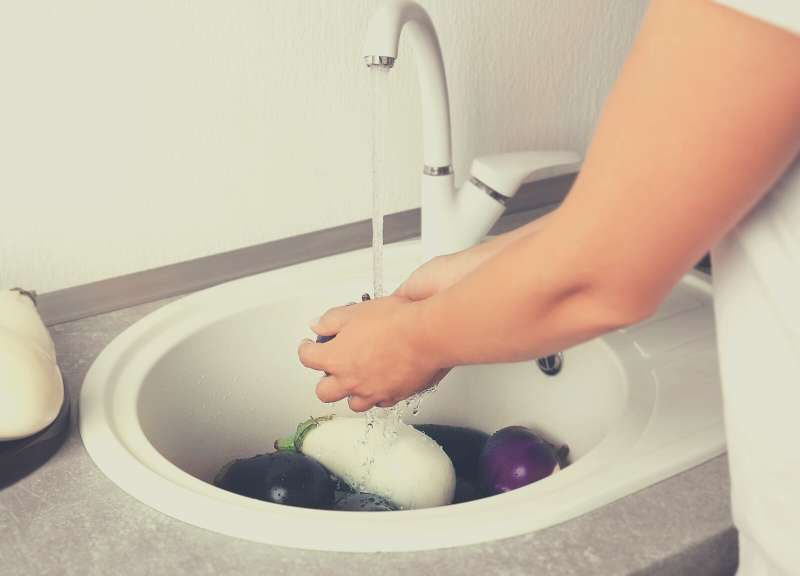If you’re looking for a new way to incorporate healthy eating into your diet, look no further than steaming eggplant.
Its unique flavor and texture make it an ideal addition to any meal. Steaming eggplant is simple, fast, and, most importantly – healthy!
But can you steam eggplant in a steamer? So if you’re wondering if it can be done in a steamer – the answer is yes!
Here’s everything you need to know about how to steam eggplant in a steamer for delicious meals that are sure to please.
Let’s get into it!
The Benefits Of Steaming Eggplant

The benefits of steaming eggplant are numerous. Steaming helps to retain the majority of its nutrients and vitamins, as well as its flavor.
It also cooks quickly and can be a great addition to any meal without sacrificing taste or nutrition.
The steam also helps break down some of the tougher parts of eggplant, making it easier to digest and more enjoyable to eat.
When cooking eggplants, steaming them is often recommended because it preserves most of their nutritional content, such as vitamins A, B6, C, and E, and minerals like magnesium, potassium, and calcium.
Additionally, boiling an eggplant can strip away some essential nutrients that help digestion. So steaming will avoid this issue altogether while allowing easy prep time in the kitchen.
Steamed eggplants are filled with antioxidants that help protect cells from damage caused by free radicals in our bodies.
Eating enough antioxidant food sources is key for overall health. Eating a few servings per week is beneficial when adding these foods to your diet plan.
See also: Can You Steam Pork Chops In A Steamer?
What’s The Difference Between Boiling And Steaming Eggplants?
Boiling and steaming eggplants involve cooking vegetables with heat, but they have different methods.
Boiling is when you cook the eggplant in a pot of boiling water until it is soft enough to be pierced easily with a fork.
Steaming involves placing the eggplant in a steamer basket or on top of some other vegetables and then placing that inside a pot of simmering liquid over low heat. The steam from this liquid helps cook the food without adding extra moisture.

Boiling an eggplant will allow even cooking as it cooks directly in hot water. However, this can cause flavor loss in the surrounding liquid if not done properly.
Additionally, boiled eggplants become mushy faster than their counterparts cooked via other methods, such as roasting or grilling, due to their higher moisture content being released into the boiling water.
On the other hand, steamed eggplants retain much more flavor while still becoming tender enough for consumption since they are only exposed indirectly to steam instead of being submerged in boiling water as boiled ones do.
Furthermore, since there isn’t additional liquid involved when steaming an eggplant, it requires less time than when boiling, making it perfect for quick meals and side dishes.
In conclusion, boiling and steaming are viable options for preparing an eggplant, depending on the desired texture or flavors.
However, each has advantages and disadvantages that should be considered before deciding how best to prepare them according to your needs.
See also: Can You Steam Frozen Peas In A Steamer?
Type Of Steamers For Steaming Eggplants
The best type of steamer for eggplants is an electric steamer. Electric steamers are ideal for steaming vegetables because they generate more heat than stovetop models and are easy to use.

An electric steamer will evenly distribute the heat throughout the cooking chamber, allowing the eggplant to be cooked quickly and evenly without burning or drying out.
The adjustable temperature settings on most electric steamers also allow you to control how much steam is being produced, which can help ensure that your eggplant comes out perfectly cooked every time.
Electric steamers offer several advantages over other types of cookware when preparing eggplants.
For example, their even distribution of heat prevents hot spots from forming during cooking, which can lead to unevenly cooked food or burnt edges in some cases.
Additionally, since the water used in an electric steamer does not come into direct contact with the food itself (as it would if boiling), there’s less risk of nutrient loss due to leaching from prolonged exposure to water.
Furthermore, since there’s no need for stirring like when using a rice cooker or microwave oven method, there’s less chance of disruption caused by inconsistent agitation.
This could cause parts of your dish to become overcooked while others remain undercooked.
Finally, many modern-day electric steamers come equipped with features such as digital timers and automatic shutoff functions.
You don’t have to worry about leaving them unattended while they’re running, thus, making them extremely convenient compared to traditional methods such as boiling on a stovetop or microwaving.
All these factors combined make an electric steamer one of the best tools available when it comes time for preparing dishes featuring tender yet flavorful veggies such as eggplant!
See also: Can You Steam Garlic In A Steamer?
How To Clean Eggplant Before Steaming?

The best way to clean eggplant before steaming is to rinse it thoroughly in cold water. This will help remove any dirt or debris on the surface of the vegetable.
After rinsing, use a produce brush to scrub away any residue and pat dry with paper towels.
It is important to ensure that all surfaces are completely dry before beginning the steaming process, as moisture can make it difficult for steam to penetrate through the skin of the eggplant properly.
You could also peel off some of its outer layers if desired before cooking for a more tender texture when cooked.
Cleaning an eggplant is essential since any remaining dirt or debris can affect its flavor and texture when cooked.
Rinsing it under cold running water helps remove most of these particles while using a brush removes anything stuck on its skin’s surface.
The eggplant should then be dried off well with paper towels so no excess moisture remains, which would prevent it from steaming evenly throughout during cooking.
Peeling off some of its outer layers beforehand can also create a softer texture upon completion, but this step is optional depending on personal preference and desired result from cooking.
See also: Can You Steam Green Beans In A Steamer?
How To Steam Eggplant In An Electric Steamer?
Here is the general guide for steaming eggplant in a steamer:
Wash the eggplant and cut it into ¾-inch thick slices, then set aside.
Fill your electric steamer with water until it reaches the fill line indicated in the user manual or on the side of your unit. Make sure to use cold tap water when filling up your steamer.
Place a metal tray onto the steam rack that came with your electric steamer and spread out the eggplant slices on top of it evenly, so they don’t overlap each other while cooking.
Place the steam rack inside the electric steamer’s cooking chamber, close its lid and plug in the power cord to turn on your unit if necessary (check the user manual).
Set the timer according to the desired time needed for cooking eggplant. 10-15 minutes should be enough.
When the timer goes off, open the lid using oven mitts if available. Hot steam will escape from the opening! Use tongs or a spatula to remove cooked eggplant and transfer it onto a plate/serving dish; serve immediately once cool enough.
FAQs
Do You Peel Eggplant Before Steaming?
It is recommended to peel eggplant before steaming, as the skin can be tough to chew.
How Do You Keep Eggplant Purple When Steaming?
To keep eggplant purple when steaming, it is best to steam the eggplant in a covered pot with a small amount of water. The lid should be left slightly open so that some steam can escape and prevent the eggplant from becoming too soft.
Additionally, adding a teaspoon of lemon juice or vinegar to the cooking water can help preserve its color.
Why Do You Soak Eggplant In Salt Water Before Cooking?
Soaking eggplant in salt water before cooking helps draw out some bitterness and reduce its spongy texture. It also helps to prevent the eggplant from absorbing too much oil during cooking.
How Do You Remove Toxins From Eggplant?
Eggplant can be detoxified by soaking it in 1 tablespoon of salt per cup of water for 30 minutes. Afterward, rinse the eggplant thoroughly and pat dry before cooking.
How Do You Get The Bitterness Out Of Eggplant Fast?
To quickly remove the bitterness from eggplant, soak it in a bowl of cold water with one tablespoon of salt for 15 minutes. Drain and rinse the eggplant before cooking.
Conclusion: Can You Steam Eggplant In A Steamer?
Yes! Not only is steaming an excellent way to prepare deliciously flavorful dishes. It also preserves much more valuable nutrition value than other conventional cooking methods.
This makes it an ideal choice for those looking for healthier meal options without sacrificing taste levels either.
With enough preparation, eggplant can be cooked to perfection in your steamer for a meal that satisfies both taste and health requirements.
Happy cooking!
